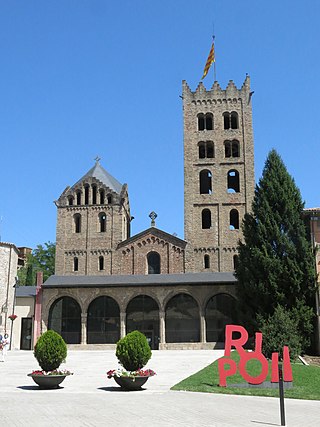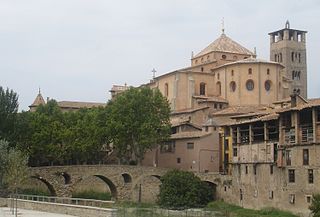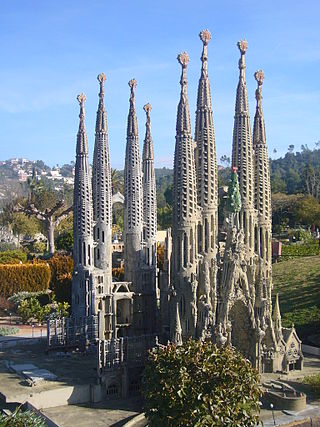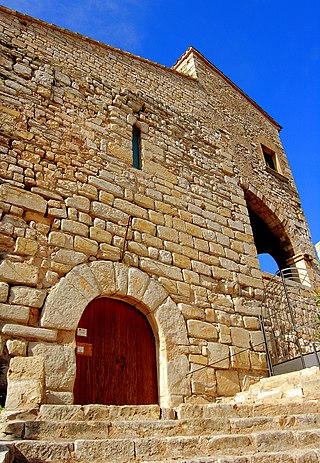
Vic is the capital of the comarca of Osona, in the province of Barcelona, Catalonia, Spain. Vic is located 69 km (43 mi) from Barcelona and 60 km (37 mi) from Girona.

Oliba was the count of Berga and Ripoll (988–1002), and later abbot of the monasteries of Santa Maria de Ripoll and Sant Miquel de Cuixà (1008–1046) and the bishop of Vic (1018–1046). He is considered one of the spiritual founders of Catalonia and perhaps the most important prelate of his age in the Iberian Peninsula. Oliba was a great writer and from his scriptorium at Ripoll flowed a ceaseless stream of works which are enlightening about his world. Most important are the Arabic manuscripts he translated into Latin for the benefit of 11th century and later scholars.

The County of Besalú was one of the landlocked medieval Catalan counties near the Mediterranean coastline. It was roughly coterminous with the modern comarca of Garrotxa and at various times extended as far north as Corbières, Aude, now in France. Its capital was the village of Besalú. Throughout most of its history it was attached to one of the other more powerful counties, but it experienced a century of independence before it was finally and irrevocably annexed to the County of Barcelona.

One of the first streams of Romanesque architecture in Europe from the 10th century and the beginning of 11th century is called First Romanesque or Lombard Romanesque. It took place in the region of Lombardy and spread into Catalonia and into the south of France. Its principal decoration for the exterior, bands of ornamental blind arches are called Lombard bands. It was characterized by thick walls and lack of sculpture in facades, and with interiors profusely painted with frescoes.

Bernard II was the Count of Besalú and Ripoll in Catalonia, the brother, co-ruler, and successor of William II, who was assassinated in 1066. The second son of William I of Besalú and his wife, Adelaide, Bernard married his first cousin Ermengarda, daughter of Ponç I of Empúries and Adelaide, sister of William I.

The Monastery of Santa Maria de Ripoll is a Benedictine monastery, built in the Romanesque style, located in the town of Ripoll in Catalonia, Spain. Although much of the present church is 19th century rebuilding, the sculptured portico is a renowned work of Romanesque art.

Santa Maria de Montserrat is an abbey of the Order of Saint Benedict located on the mountain of Montserrat in Monistrol de Montserrat, Catalonia, Spain. It is notable for enshrining the image of the Virgin of Montserrat. The monastery was founded in 1025 and rebuilt between the 19th and 20th centuries. With a community of around 70 monks, the abbey is still in use to this day.

Olegarius Bonestruga was the Bishop of Barcelona from 1116 and Archbishop of Tarragona from 1118 until his death. He was an intimate of Ramon Berenguer III, Count of Barcelona, and often accompanied the count on military ventures.

The Diocese of Vic is a Latin diocese of the Catholic Church with its seat in the city of Vic in the ecclesiastical province of Tarragona in Catalonia, Spain. Its cathedral is a basilica dedicated to Saint Peter.

The Monastery of Sant Benet de Bages is a former Benedictine monastery, in the comarca of Bages, Catalonia, Spain. The Romanesque monastery was thoroughly restored at the beginning of the twentieth century by the Catalan architect Josep Puig i Cadafalch.

Bernard I, called Taillefer, was the Count of Besalú in Catalonia from 988 until his death. He was the eldest son of Oliba Cabreta and Ermengard of Empúries, and succeeded his father in Besalú while his younger brothers Oliba and Wifred, inherited Berga–Ripoll and Cerdagne–Conflent, respectively. He was the great-grandson of Wilfred the Hairy, and therefore belonged to the House of Barcelona.

The Monastery of Sant Joan de les Abadesses is a monastery in the comarca of Ripollès, Catalonia, northern Spain. Until the year 945 it was the only female monastery in the area.

Catalunya en Miniatura is a miniature park inaugurated in 1983 in Torrelles de Llobregat, 17 km (11 mi) from Barcelona. The park is 60,000 m2 (650,000 sq ft), 35,000 m2 (380,000 sq ft) of them devoted to the scale models, it is one of the largest miniature parks in the world, and the largest of the 14 miniature building exhibitions present in Europe. It displays 147 models of palaces, churches, bridges and other buildings from Catalonia and Mallorca and it includes all the major works by the renowned architect Antoni Gaudí.
Wilfred or Wifred, called the Hairy, was Count of Urgell, Cerdanya, Barcelona, Girona, Besalú and Ausona. On his death in 897, his son, Wilfred Borrell, inherited these counties, known by the historiography as the Catalan counties.

Froia was a canon of the cathedral of Vic from 957 and bishop from 972. His predecessor, Atto, tried to have Vic raised to archiepiscopal status, but was assassinated by his opponents. Elected to replace him, Froia was consecrated by Ermengol, archbishop of Narbonne, who had opposed Atto because Vic was a suffragan diocese of Narbonne.
Atto was the bishop of Vic from 957 until his death. He had the bishopric of Vic raised to an archbishopric, but was assassinated by his opponents in 971.

Santa Cecília de Montserrat is a Benedictine monastery in Marganell, Catalonia, Spain.

Borrell was the bishop of Vic from 1010 until 1017. He was elected to replace Arnulf, who had died in battle against the Córdobans, and his episcopate coincided with the renewed colonisation of the west of Catalonia.
Idalguer was the second bishop of Vic (899–914) after the see was re-founded. He played a leading role in re-organising the diocese, consecrating churches at Lluçà, Manlleu and Sant Julià de Vilatorta.
















